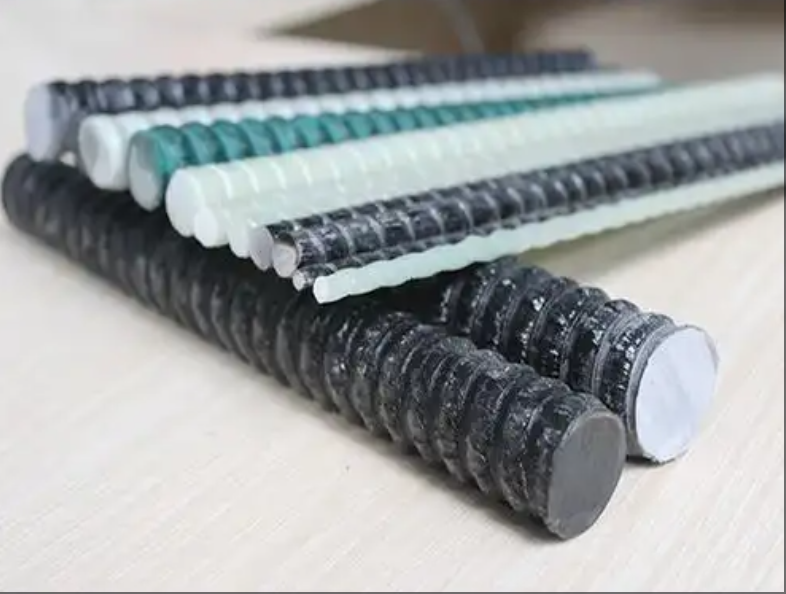- May 14, 2025
- Posted by: wellcoindustries
- Category: Rebar
Introduction
Corrosion of reinforcing steel is the silent budget‑killer hiding inside many coastal, bridge, and water‑retaining concrete projects. When chloride‑laden moisture reaches carbon steel, rust expands, spalls cover concrete, and owners are forced into disruptive repairs. Fiberglass reinforced polymer rebar (often shortened to FRP rebar) eliminates that entire degradation mechanism because it contains no metal to oxidise. In this guide, you will learn exactly how the composite chemistry stops corrosion and where the economic break‑even lies for your next job.
Who we are: Wellco Industries is a vertically‑integrated FRP manufacturer and global distributor. Our technical team advises contractors, OEMs, and purchasing managers on specification, logistics, and field training so every stick of rebar performs as promised.

Understanding Corrosion in Traditional Steel Rebar
The chemistry of rust: chloride ions, carbonation, and pH shift inside concrete
Steel rebar is protected by concrete’s natural high‑alkaline environment—until chlorides from de‑icing salts or seawater penetrate the cover. Chlorides destroy the passive oxide film and drive an electro‑chemical reaction that converts iron to expansive iron‑oxide. Carbonation lowers pH, accelerating the cycle.
Hidden costs for owners: repair budgets, downtime, and environmental impact
The U.S. Government Accountability Office reports corrosion creates $13.6 billion in direct bridge costs each year. That figure excludes lane closures, carbon‑intensive repair materials, and user delays—which a 2025 ASCE briefing says push true annual impacts far higher.
Why Fiberglass Reinforced Polymer Rebar Stops Corrosion
Non‑metallic glass fiber + vinyl‑ester matrix: immune to chloride attack
FRP rebar combines e‑glass fibers and a vinyl‑ester resin. Neither constituent rusts, so chloride ingress is irrelevant. The polymer matrix also blocks alkali–silica reaction pathways that attack some aggregates.
Lab & field proof of durability
A neutral‑salt‑spray test (ASTM B117) run for 1,000 h on glass‑fiber FRP recorded 0 % measurable mass loss and no surface pitting . Long‑term creep‑rupture modelling extrapolates >100‑year tensile‑strength retention under service loads. Field pull‑out samples from bridges after 15–20 years showed no loss of modulus or glass‑transition temperature.
Real‑World Case Study: Coastal Pier Rehabilitation*
Project snapshot (2019): switching to FRP cut lifecycle costs 40 %
An Atlantic‑seaboard municipality planned a deck overlay on a 1970s fishing pier severely damaged by rebar corrosion. Value‑engineering replaced epoxy‑coated steel with 15 mm FRP bars. The bid increased material cost by $90 k but eliminated cathodic‑protection hardware and halved installation time.
Key takeaways for contractors & purchasing managers
Weight: FRP is ¼ the density of steel—crews handled 12 m bundles without cranes.
Installation speed: Straight‑cut bars tie using plastic clips and fiberglass stirrups; bend radii are replaced by lap splices.
Performance: Three seasons later, the pier’s chloride profiles remain below threshold and the project team reports zero corrosion claims.
Expert insight: “Lighter bars meant fewer injuries and we skipped zinc‑rich primers altogether,” notes the lead civil engineer, who requested anonymity due to municipal procurement rules.
*Client anonymized to protect proprietary details
Design & Installation Best Practices
Codes and standards you must know
ACI 440.11‑22 – design of FRP‑reinforced concrete
ASTM D7957 – specification for structural FRP bars
ICC‑ES AC454 – acceptance criteria used by many U.S. building departments
Cutting, bending substitutes, and tying
Wellco field engineers recommend:
Shear with a diamond‑coated chop saw; seal cut ends with vinyl‑ester epoxy.
Replace tight hooks with pre‑formed FRP stirrups or increase lap splice length per ACI 440.
Use nylon or proprietary composite ties to avoid galvanic couples.
Cost‑Benefit Analysis of Switching to FRP Rebar
Upfront price vs 60‑year ROI
| Item | Epoxy‑Coated Steel | FRP Rebar |
|---|---|---|
| Material price (USD/ft) | 1.10 | 1.80 |
| Weight (lb/ft) | 0.67 | 0.17 |
| Estimated maintenance @ 60 yrs | $150 / m³ concrete | $0 |
| Carbon footprint (kg CO₂e/ft) | 2.3 | 0.9 |
Even with a 65 % higher material price, modelled lifecycle cash flow shows FRP delivering 26 % net savings by year 40 and 37 % by year 60 when avoided patch repairs, traffic control, and CO₂ pricing are included.
ESG & sustainability wins
Lightweight pallets cut transport fuel; vinyl‑ester production emits 40–70 % less CO₂e than steel smelting. Many public owners now award LEED v4 “Innovation in Design” credits for non‑corrosive reinforcement choices.
Conclusion
Fiberglass reinforced polymer rebar breaks the rust‑repair‑rust cycle, extends service life beyond a century, and supports both fiscal and environmental goals. If you are designing or rehabilitating concrete assets in aggressive environments, contact Wellco Industries for technical datasheets, sample bars, or a fast project‑specific quote.
Frequently Asked Questions
Q1. Is FRP rebar approved by building codes?
Yes. ACI 440.11‑22 provides design equations, and most U.S. jurisdictions accept ICC‑ES‑evaluated products.
Q2. Can FRP bars be bent on site?
No. Because the fibers are continuous, cold bending is not allowed. Specify factory‑made stirrups or use longer lap splices.
Q3. How does FRP perform in fire?
The glass fibers retain integrity above 500 °C, but the resin softens around 120 °C. Designers should add concrete cover or fire‑proofing per ACI guidance.
Q4. Are there size limits?
Commercial diameters range from #2 (6 mm) to #10 (32 mm). Custom sizes can be pultruded for OEM or large‑volume orders.
